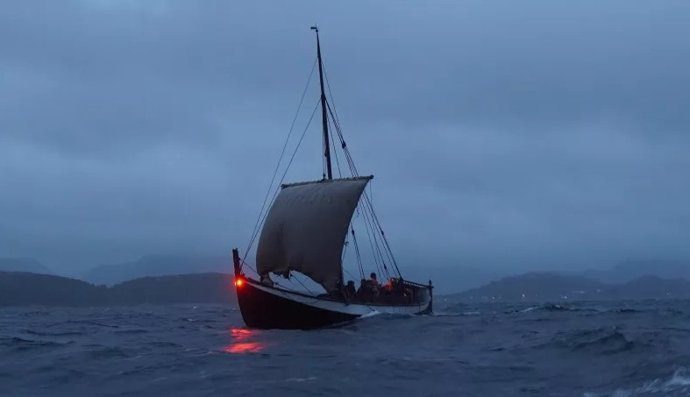Greer Jarrett undertook voyages with experimental ships to understand Norse seafaring capabilities in Greenland: Sailing at night on one of the largest expeditionary ships probably used by the Norse. – GREER JARRETT
September 30 () –
Vikings and indigenous people of the American Arctic probably met and traded with ivory in remote areas of Greenlandseveral centuries before Christopher Columbus discovered America.
An international research team led by Lund University (Sweden) has analyzed the ancient walrus DNA to retrace the Viking Age walrus ivory trade routes and come to that conclusion. The study has now been published in Science Advances.
In medieval Europe, there was a huge demand for exclusive products, including walrus ivory. The Vikings played a vital role in the ivory trade, which fueled Norse expansion into the North Atlantic, to Iceland and then to Greenland, in search of new sources of ivory.
“What really surprised us was that much of the walrus ivory exported to Europe came from very remote hunting areas, located deep in the High Arctic. Until now, it had always been assumed that the Norse simply hunted walrus near their main sources. settlements in southwest Greenland,” says in a statement Peter Jordan, Professor of Archeology at Lund University.
The researchers used “genetic fingerprints” to reconstruct precisely where the traded walrus artifacts came from.
“We extracted ancient DNA from walrus samples recovered from a wide range of locations in the North Atlantic Arctic. Using this information, we were able to compare the genetic profiles of walrus artifacts traded by the Greenland Norse in Europe with very specific arctic hunting areas“explains Dr. Morten Tange Olsen, associate professor at the Globe Institute in Copenhagen.
As new results began to emerge, another key question arose: If ivory was being sourced from the High Arctic, did the Greenland Norse have the necessary maritime skills and technologies? to venture so deep into the frozen waters of the Arctic?
Research team member Greer Jarrett sought answers to this question in a unique way: in fact, he reconstructed probable shipping routes, conducting experimental voyages on traditional Norwegian clinker-built ships: granulated product obtained by calcination of limestone and clay.
“Walrus hunters probably departed from Norse settlements as soon as the sea ice retreated. Those who targeted the far north had a very narrow seasonal window within which to travel along the coast, hunt walrus, process and store the skins and the ivory on board their ships, and return home before the seas froze again“says Greer Jarrett, a PhD researcher at Lund University.
After the Norse completed their dangerous journeys, what might they have found? Importantly, these remote High Arctic hunting grounds were not an empty polar wilderness; They would have been inhabited by the Thule Inuit and possibly other indigenous peoples of the Arctic, They also hunted walruses and other marine mammals.
A SPACE WITHOUT SEA ICE FACILITATED CONTACTS
The new research provides further independent evidence for the long-debated existence of very early encounters between European Norse and indigenous North American peoples, and also confirms that the Northern Waters Polynya was an important setting for these intercultural encounters.
“This would have been the meeting of two completely different cultural worlds. The Greenland Norse had European facial features, probably had beards, wore woolen clothing, and sailed in plank-built boats; They hunted walruses in resting places with iron-tipped spears“Jordan says.
In contrast, the Thule Inuit were specialists adapted to the Arctic and used sophisticated harpoons that allowed them to hunt walrus in open water. They would have been wearing warm, insulating fur clothing and would have had more Asian facial features; They paddled kayaks and used open umiak boats, all of them made with animal skins stretched over frames.
“Of course, we will never know precisely, but on a more human level, these extraordinary encounters, set in the vast and intimidating landscapes of the High Arctic, would likely have involved a degree of curiosity, fascination and excitement, all of which encouraged interaction. social, sharing and possibly exchange.
“We need to do a lot more work to properly understand these interactions and motivations, especially from a more ‘Eurocentric’ indigenous and Nordic perspective“concludes Jordan.




![[Img #74662]](https://thelatestnews.world/wp-content/uploads/2024/12/Organisms-with-the-shortest-life-150x150.jpg)








![[Img #74662]](https://thelatestnews.world/wp-content/uploads/2024/12/Organisms-with-the-shortest-life-300x200.jpg)


Add Comment